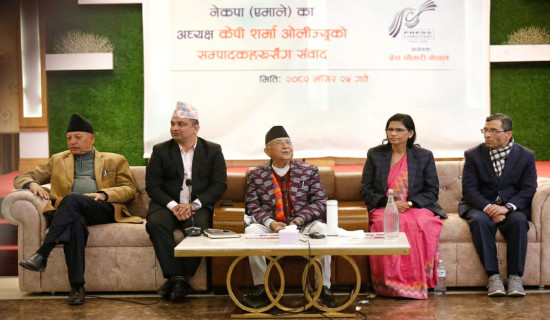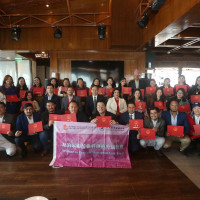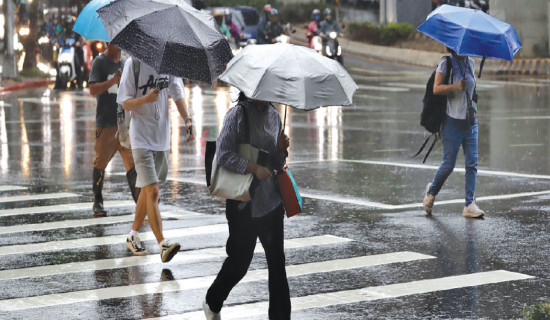- Thursday, 11 December 2025
Nepal performs poorly to end plastic pollution
Kathmandu, June 5: World Environment Day is being observed on Thursday with the theme ‘End Plastic Pollution,’ highlighting the urgent issue of plastic waste, which is contaminating the water we drink, the food we eat and even our bodies.
For decades, plastic pollution has been a widely discussed issue, spreading to every corner of the world, from the top of the world, Sagarmatha (Mount Everest), to the seas, and impacting entire ecosystems. In this situation, the day will highlight the growing scientific evidence on the impacts of plastic pollution and drive momentum to refuse, reduce, reuse, recycle and rethink plastic use, UNEP said. It also said in 2025, the world is expected to consume 516 million tonnes of plastics.
Failed attempts on ban
In Nepal, the government first attempted to ban plastic bags thinner than 40 microns by publishing a notice in the Nepal Gazette on April 1, 2015. It was the country’s first nationwide initiative to regulate plastic use. However, implementation remained a challenge, as the country soon had to focus on recovering from the devastating Gorkha earthquake.
Again, on August 17, 2022, the government reintroduced a nationwide ban on plastic bags thinner than 40 microns. “Since then, the Department of Environment has been strictly monitoring the production of such plastic bags and discouraging their use,” said Sailesh Kumar Jha, Deputy Director General at the Department of Environment.
“We are monitoring the factories, and importers are also under our observation. We are seizing such plastics wherever found. However, it will take time, as we need to provide alternatives. The process of introducing eco-friendly options is still slow, and we must improve our policies and plans to make it effective,” he said.
According to Jha, the need to control plastic pollution goes beyond banning thinner plastics, as thicker plastics also pose significant environmental threats. “We need to provide alternatives to plastic alongside the ban. There are a few factories in the country producing biodegradable bags made from cornstarch and other eco-friendly materials. These alternatives are slowly emerging. The department has also introduced policy standards to regulate such production,” he said.
Referring to the recent budget speech, Jha said the government has included plans to help industries switch to eco-friendly alternatives. Although the budget did not specify exact funding for these efforts, it clearly shows a strong commitment to environmental sustainability, he said.
Plastic factories that are already established need to change their dye to produce thicker plastics, and they also require incentives to do so. “The collection and reuse of plastic should be more effective. Currently, collectors face policy hurdles, such as having to pay kabaddi (waste materials) tax when transporting collected plastic waste to another municipality, and this needs to be eased,” he said.
Policy barriers
Environmentalist Bhusan Tuladhar said that some private entrepreneurs are running plastic recycling factories by mixing plastic into construction materials like Aalkatra. However, they lack clear policy guidelines and need incentives to sustain their operations.
These plastic recycling factories also face challenges with the quality and quantity of raw materials due to an insufficient supply of suitable plastic waste. Referring to one factory owner, he said that most of the plastic coming from Kathmandu is unusable, about 40 per cent of it must be discarded because it is not suitable for recycling.
Many young entrepreneurs are stepping into the recycling business, with some even producing tables made from plastic waste. However, they lack sufficient incentives to grow. Tuladhar stressed that Extended Producer Responsibility (EPR) must be strengthened, and policies and laws should be effectively enforced to control plastic pollution. Following the government’s announcement of ban on plastic bags thinner than 40 microns, several districts such as Parbat, Myagdi, Jhapa and Ilam have declared themselves plastic-free. However, single-use plastics and bags thinner than 40 microns are still widely available in shops across the country, with the situation particularly severe in urban areas like Kathmandu.
According to a study, the Valley generates around 1,200 metric tonnes of solid waste daily, with around 16 per cent of that waste estimated to be plastic.
Jha said that single-use plastic is primarily a behavioral issue. “People need to be aware of the harmful effects of plastics and should carry their own bags to avoid the plastics. The government alone cannot control market usage, individuals must also take the initiative,” he added.
Missed opportunity
Bimal Bastola, Chief of Green Road Waste Management Pvt. Ltd., who has been collecting and recycling unrecycled plastic waste for the past eight years, said that policy hurdles are making it difficult to continue the business, especially when it comes to recycling packaging materials such as instant noodle wrappers, biscuit and chocolate packets, and gutkha pouches.
“These materials are very difficult to recycle. There should be a policy that holds production companies responsible for managing the waste generated from their products. Either they should collect the waste themselves or partner with private companies to do so, but they must provide proper incentives,” he said.
The company has been producing plastic dust by collecting plastic waste from the Annapurna trekking area in collaboration with the Annapurna Conservation Area Project (ACAP). It also works with schools and the municipality in Pokhara to gather additional waste. The plastic dust they produce, made from non-recyclable plastic, is then supplied to cement factories, used for making plastic planks, and in some cases, for road construction.
“There is currently no policy in Nepal allowing the use of plastic dust for road construction, even though many other countries have adopted it as an alternative material. The government should formulate regulations to promote the use of plastic waste in road construction as well,” Bastola said.
The solution is inside us but the only need is policy and regulations, which facilitate such waste to change into income, he said.
According to UNEP, globally, an estimated 11 million tonnes of plastic waste leak into aquatic ecosystems each year, while microplastics accumulate in the soil from sewage and landfills, due to the use of plastics in agricultural products. The annual social and environmental cost of plastic pollution ranges between US$300 billion and US$600 billion.
















